Picture yourself standing on the edge of a cliff in Iceland, wild winds tangling your hair, as the emerald green moss clings to black volcanic rock beneath your feet. The only sounds are distant waterfalls and your own heartbeat. But what if, in the not-so-distant future, this moment wasn’t possible? Around the world, some of the most breathtaking places are teetering on the edge—caught between welcoming the world and protecting what makes them magical. The dream of discovering these spots may soon slip away. Here’s where you might want to book your ticket before the door quietly closes.
Bhutan Preserving Culture Over Crowds

Bhutan feels like a fairytale kingdom—a land of fluttering prayer flags, crimson-robed monks, and cloud-wrapped monasteries perched impossibly on cliffs. The air smells crisp and piney, and locals greet you with warm, genuine smiles. But Bhutan’s magic comes at a price: to keep its culture and environment intact, the government has always put limits on tourism. Recently, whispers have grown louder about further tightening visitor numbers or hiking up the daily tourism fee. If you’ve ever dreamed of hiking to Tiger’s Nest or tasting buttery yak milk tea, consider moving Bhutan to the very top of your list. The best time to visit is spring or autumn, when festivals light up the valleys. Respect for local customs—like modest dress and quiet reverence in temples—isn’t just polite, it’s required. If you want to experience Bhutan’s serenity, your window may be closing fast.
Venice Italy Battling Overtourism

Imagine gliding through Venice’s labyrinth of canals at sunrise, the city’s ancient stones glowing pink, the air salty and damp. Now picture crowds so thick you can barely see the water—this is Venice’s daily reality. With over 20 million tourists a year, the city is literally sinking under the weight. Recent moves to charge day-trippers an entry fee and restrict group sizes are only the beginning. There’s talk of limiting or even banning certain types of tourist visits to save fragile bridges and historic plazas. If you want to hear church bells echo through empty streets or drink a perfect espresso in peace, go soon—and travel light. Arrive in shoulder seasons (April–June, September–October) to dodge the worst crowds, and try wandering into lesser-known sestieri for a taste of local life. Venice’s fragile beauty may soon be reserved for only the most respectful travelers.
Thailand A Shift Toward Sustainable Tourism

Thailand’s beaches are legendary—think turquoise water, limestone cliffs, the scent of grilled seafood drifting from tiny stalls. Once, places like Maya Bay were wild and pristine. Today, some are closed off, battered by millions of flip-flops and plastic bottles. The Thai government is rethinking its open-arms policy, with stricter visa rules and seasonal closures of popular islands already in effect. Rumors swirl of even tighter restrictions. If you want to experience the gentle chaos of Bangkok or the blissful quiet of Chiang Mai’s temples, don’t wait. The best time to visit is during the cool, dry months from November to February. To tread lightly, avoid single-use plastics, support small local businesses, and respect sacred sites—shoes off, voices low, always. Thailand’s open smile may not last forever.
Iceland Protecting Natural Wonders

There’s nothing like Iceland’s landscapes: geysers hissing, glaciers gleaming, and fields of lupine stretching to the horizon. But this raw beauty is fragile—paths are eroding, wildlife is stressed, and locals are sounding the alarm. Authorities are weighing caps on visitors to popular spots like the Blue Lagoon and Golden Circle, with some highland areas already off-limits to protect delicate moss and nesting birds. If you want to soak in a natural hot spring while snowflakes melt on your eyelashes, book soon—and look for off-the-beaten-path adventures. Late spring and early autumn bring fewer crowds and dazzling light. Always stick to marked trails (the moss can take decades to recover from a single footprint), and learn a few words of Icelandic—locals appreciate the effort. Iceland’s wild silence is precious, and it may only get harder to find.
Galápagos Islands Ecuador A Fragile Ecosystem

The Galápagos Islands feel like stepping into another world: blue-footed boobies dance on lava rocks, sea lions nap on empty beaches, and giant tortoises lumber through misty highlands. But this Eden is under siege—too many visitors threaten rare species and delicate habitats. The Ecuadorian government has hinted at drastic cuts to visitor numbers, higher entry fees, and stricter cruise regulations. If seeing Darwin’s inspiration is on your bucket list, act fast. The best months are June to November for wildlife lovers, but every season is special. Join a small, eco-certified tour group, pack reef-safe sunscreen, and never touch or feed the animals. The chance to walk among living legends might not last much longer.
Machu Picchu Peru A Cultural Treasure at Risk

Machu Picchu’s misty peaks and mysterious ruins have called to adventurers for a century. There’s nothing quite like catching your first glimpse as sunlight spills over ancient stones. But this wonder is cracking under pressure—hundreds of thousands of feet trample fragile pathways every year. In response, Peru now limits daily visitors and tightly controls Inca Trail permits, with even stricter rules on the horizon. If you’re dreaming of sunrise above the citadel, plan early and book permits months in advance. The dry season (May to September) is best for hiking, but even then, the weather can be wild. Carry only what you need, respect the guides’ instructions, and pause to listen to the wind—this is sacred ground. Machu Picchu’s magic is real, but its future is uncertain.
Bali Indonesia A Balancing Act

Bali is a riot of sound and color—roosters crowing, incense curling through morning markets, surf crashing on black sand beaches. But paradise has its problems: traffic jams, water shortages, and a culture stretched thin by endless waves of visitors. Local leaders are debating bold steps, from tourist taxes to outright bans in sacred areas. If your bucket list includes Bali’s emerald rice terraces or Ubud’s monkey forests, don’t put it off. The shoulder months of April, May, September, and October bring fewer crowds and cooler weather. Dress modestly for temple visits, skip single-use plastics, and learn a few Bahasa Indonesia phrases. Bali’s gentle spirit is under threat, and the welcome mat may soon be rolled up.
Australia Protecting Unique Wildlife

Australia dazzles with its diversity—coral reefs teeming with neon fish, eucalyptus forests echoing with kookaburras, and deserts blooming with wildflowers after rain. But tourism is a double-edged sword: crowds threaten the Great Barrier Reef, and careless visitors disturb endangered animals like koalas and cassowaries. The government is responding with tougher regulations: limited access to some national parks, stricter reef permits, and higher park fees. If snorkeling with manta rays or hiking in the Outback is your dream, the time to go is now. Visit between April and October for the best weather. Always follow park rules—never feed wildlife, and leave no trace. Australia’s wild heart beats strong, but it’s under watchful guard.
The Rise of Travel Restrictions

From remote Himalayan valleys to sun-soaked Mediterranean canals, the world’s most beautiful places are facing tough choices. Overtourism, environmental threats, and cultural erosion are forcing governments to draw new lines in the sand. For travelers, this means doing homework before booking, traveling with respect, and savoring every moment—because some doors may close, maybe forever. The next trip you take might truly be once-in-a-lifetime.






